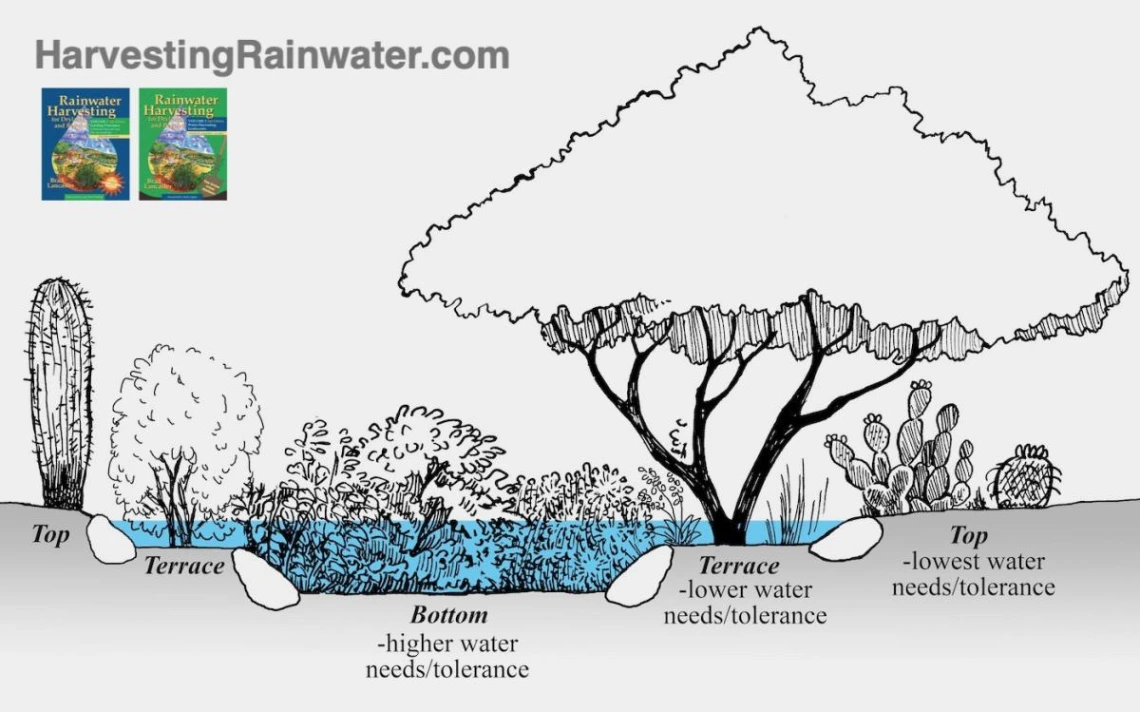
Common Names:
- English: Desert Oregano / Wright’s Beebrush
- Spanish: Oreganillo
Family Name: Verbenaceae
Botanical Name: Aloysia wrightii
Rain Garden Zone: Although A. wrightii thrives in the terrace rain garden zone, it can grow well in both the bottom and top rain garden zones as well. The terrace zone is typically atop a terrace or on the bank of a basin or swale. These sites have more shallow, less-frequent, and more temporary pooling than in bottom zone. The bottom zone is typically the bottom of a basin or swale. This location is prone to temporary pooling of water as well as nighttime cool air pockets. The top zone, is the area beside, but not in the basin where plant root crowns stay dry, but where roots can access water harvested below in the basin. This location is the driest and warmest of the three zones.

Reproduced with permission from "Rainwater Harvesting for Drylands and Beyond" by Brad Lancaster, HarvestingRainwater.com
Harvest Season: February - April, late June - September
Harvest Techniques: Pinch back tender growing tips and clip the leaves of oreganillo. Identification of herbs prior to harvest is important—ensure that oreganillo has been properly identified.
Planting Season: Monsoon
Landscape Cultivation: No scarification is needed for oreganillo. It should be planted with the summer rains.
Characteristics: A. wrightii is a shrub reaching 5 feet tall and about as wide. The leaves are scalloped ovals with white hairs on the lower leaf surface and the flowers are white and grow in dense spikes. Oreganillo is highly aromatic when its leaves are crushed or ground.
Ecological Benefits: The fragrant oreganillo attracts bees and other pollinators, hence the English common name of beebrush.
Practical Uses:
- Food - As the name suggests, oreganillo can be used as a spice much like oregano. Oreganillo can be added to spice mixes or any savory recipe. Additionally, it may be consumed as a tea by steeping the leaves in hot water.
- Domestic Animals - A. wrightii is a good plant to have around honeybees, as the honey produced from the nectar if this plant has a nice flavor. Additionally, livestock may graze on this shrub.
References:
- Desert Harvesters. (2018). Eat mesquite and more: a cookbook for Sonoran desert foods and living. Tucson, AZ. RainSource Press.
- Hodgson, W. C. (2001). Food plants of the Sonoran desert. Tucson, AZ. University of Arizona Press
- Lancaster, B. (2019) Rainwater harvesting for drylands and beyond, 3rd edition. Tucson, AZ. RainSource Press.
- Rea, Amadeo M. (1997). At The Desert's Green Edge - An Ethnobotany of the Gila River Pima. Tucson, AZ. University of Arizona Press.
For more information on this plant, see the Campus Arboretum's Desert Landscape site.
Go to the next tour stop: blue paloverde page or Return to the main Dunbar Spring tour page

